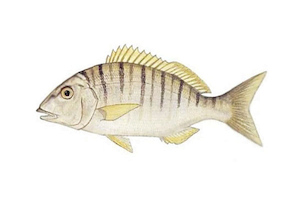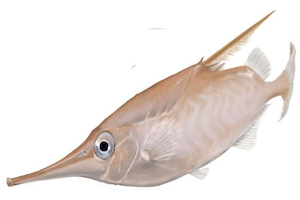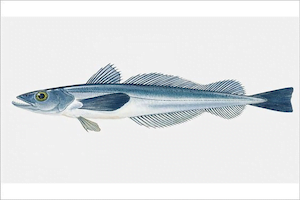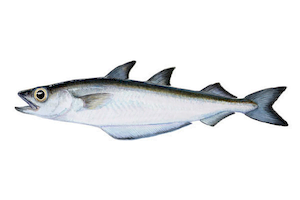Solea Solea
– Common Sole –
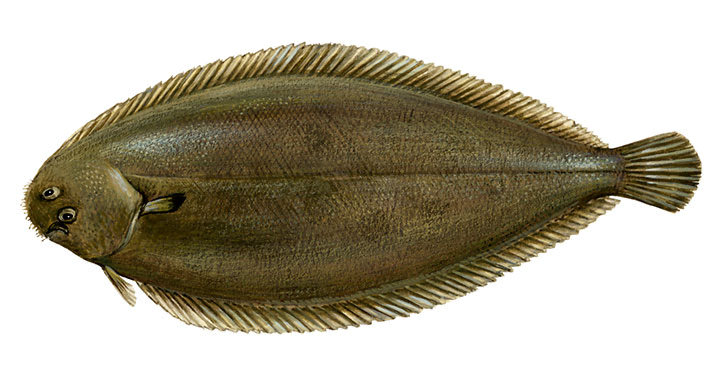
| Conservation status |
|---|
 Data Deficient (IUCN 3.1)[1] |
| Scientific classification |
Solea solea
(Linnaeus, 1758)
| Kingdom: | Animalia |
| Phylum: | Chordata |
| Class: | Actinopterygii |
| Order: | Pleuronectiformes |
| Family: | Soleidae |
| Genus: | Solea |
| Species: | S. solea |
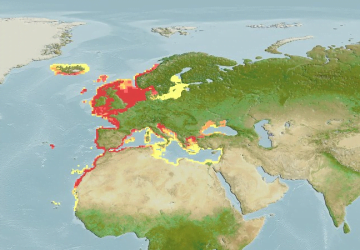
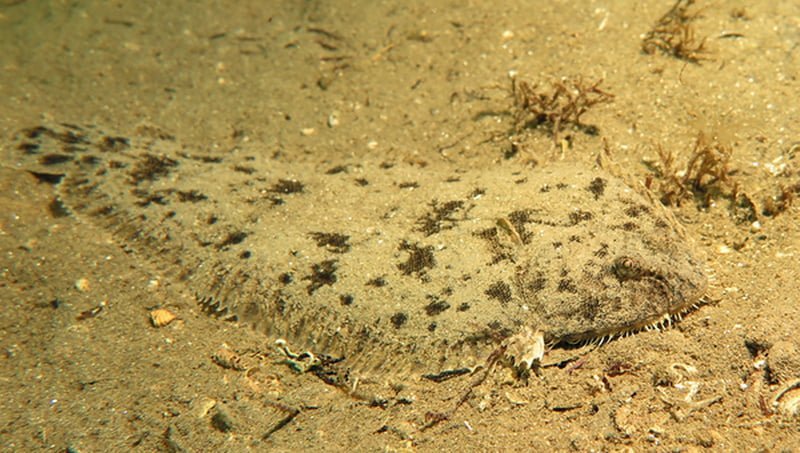
The common sole, Dover sole, or black sole (Solea solea) is a species of flatfish in the family Soleidae. It lives on the sandy or muddy seabed of the northern Atlantic and the Mediterranean Sea where it often semi-immerses itself in the substrate. The upper side is greyish-brown while the underside is white. It grows to a maximum length of about 70 cm (28 in). The species is prized as a food fish, being caught mostly by trawling on the seabed.
Description
The small eyes are close to each other on the right side of the body. This gives the fish the possibility of lurking half-buried in the sand for passing prey. The common sole, just like all other flatfishes, hatches as an “ordinary” fish with one eye on each side of the body. The young metamorphose to flatfish when they are about one centimeter long. The upper side is greyish-brown and the underside is white. The common sole approaches a maximum length of 70 cm (28 in).
We first notice in this flatfish its characteristic oval shape , which is not found in the other flatfish most frequently encountered by divers.
Its size is generally between 30 and 40 cm. Certain individuals reached 70 cm, for a weight of 3 kg (age of these individuals: 20 years; a two-year-old male individual is 30 cm for a weight of 350 g). The adult sole, a right-handed (or dextral) flatfish, rests on its left side and has its eyes on the right side. The color of this fish is very variable: bluish gray to yellowish brown! The body is often marked with mottling and dark spots. The muzzle of the sole is rounded and shows a small arched mouth, located before the end of the head. Its eyes are small and wide apart (for a Soléidé). The caudal has a rounded edge at the end of which we can often notice a dark fringe . On the seabed (or at the fishmonger’s!) One will notice the black spot (sometimes golden or brown) located at the back and towards the top of the pectoral fin . (Be careful, other species of sole have other forms of spots…). The dorsal and anal fins are generally bordered in white and united to the caudal by a thin membrane.
Distribution and Habitat
It has a preference for relatively shallow water with sand or mud covering the bottom. It is found in the Eastern Atlantic Ocean, from the south of Norway to Senegal, and in almost all of the Mediterranean Sea. In the winter, it withdraws to the somewhat warmer waters of the southern North Sea.[2] In the UK, a small sole is commercially called a “slip”.
The common sole lives from the shore to a depth of 200 m, but most often before 70 m of bottom, mainly on sandy or muddy environments. It can be found in ports or in estuaries, at the edge of fresh water (it supports a salinity of 10 ‰).
Similar Species
There are several species of sole, sometimes quite close to each other ( Solea aegyptica, Pegusa lascaris , Microchirus theophila and Buglossidium luteum , very present in the North Sea…).
It is recommended to consult specialized books in case of doubt, but Solea solea is the species most frequently encountered by divers on our coasts.
Let us quote Solea senegalensis , which differs from Solea solea by a spot on the pectoral which is less obvious, less uniform, and which differs especially from the latter by a number of precaudal vertebrae equal to 9, against 10 for Solea solea (criterion not appreciable) while diving).
Alimentation
It feeds on various small crustaceans, molluscs, worms… that it spots by olfaction (detectable olfactory tubes) and in a tactile manner. You can spot sensitive taste buds under his muzzle.
Reproduction
The sexual majority of this fish is reached around 4 years old.
The reproduction takes place mainly from March to May (this varies according to the regions) and the observations of the plankton show eggs which reach a diameter of 1.5 mm (flotation ensured by a lipid droplet also having a role of food reserve). The female can lay hundreds of thousands! The larva is first similar to that of a classic fish, then after metamorphosis, the young (size approximately 15 mm), asymmetrical, seek coastal waters.
Markings have shown annual migrations over more than 180 km to allow adults to reach the spawning grounds!
Various Biology
Very common species along some shores of the North Sea where it is actively fished, its flesh being delicate and highly esteemed.
The sole has an essentially nocturnal activity. During the day, it can be observed more or less buried in the sediment.
For its movements over long distances, the sole rises close to the surface and is passively transported by sea currents.
In winter the sole moves away from the coast, to return there in spring and summer.
The black spot of the pectoral of the sole is interpreted as an application of Batesian mimicry, by imitation of the dorsal, poisonous, of the vives, such as for example the great vivid ( Trachinus draco).
Further Information
The small soles are sold under the name of “sole-portion”, and can satisfy a small appetite …
The abundant fishing of this fish, due to its high commercial value, leads to disputes about the width of the mesh allowed for its capture. The demand for this fish is greater than the supply …
The inshore fishery for brown shrimp results in accidental catches of young sole, which is regrettable for the populations of this fish.
Ecology
An ectoparasite of the common sole is the leech Hemibdella soleae. The larvae settle on the upper surface of the fish, the only part not buried in the sediment, and after further development migrate to the underside, where they attach themselves with their suckers, feeding on the fish’s blood.[3]
Cuisine
Chefs prize Dover sole for its mild, buttery, sweet flavour and versatility, and for its ease of filleting. The fish yields fillets that hold together well in a variety of recipes.[4]
The name “Dover” comes from Dover, the English fishing port landing the most sole in the 19th century.
In 2010, Greenpeace International added the common sole to its seafood red list. “The Greenpeace International seafood red list is a list of fish that are commonly sold in supermarkets around the world, and which have a very high risk of being sourced from unsustainable fisheries.”[5][6]
Other species named “Dover sole”
Because of its prestige, the name “Dover sole” was borrowed to name the eastern Pacific species Microstomus pacificus, a quite distinct species with different culinary properties: the Pacific sole has thinner, less firm fillets and sells for a lower price.
Semialbino sole from the North Sea





























